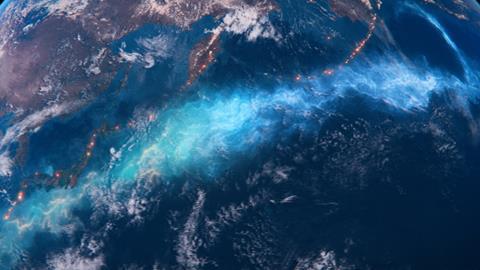The Bristol-based VFX houses explains how it visualised the global ocean current

Currents bring a different personality to each of the Earth’s oceans, with the different mixes of warm and cold water supporting different underwater ecosystems, regulating global climate, and influencing the migration of marine animals. This unseen yet vital phenomenon is visualised in a never-before-seen way in Netflix’s Our Oceans by Bristol-based Moonraker VFX.
Our Oceans is a five-part Netflix documentary series, narrated by Barack Obama, that explores the world’s ocean currents and the energies and forces behind them. Moonraker was commissioned by production house, Wild Space, to help visualise the global ocean current, a phenomenon not visible to the human eye. Using real-world scientific data and a bit of artistic flair, Moonraker produced high-end, beautiful visuals that remained grounded in reality and driven by science.
Real-world data
Ocean currents transport cold water from the poles to the tropics, and warm water from the equator outwards. Using a NASA dataset and information from oceanographers, Moonraker was able to visualise the path and locations of the different currents. They also made use of NASA’s perpetual ocean, which provided additional information on how the oceans look when viewed from space. From there, the team created a flat texture, on which the paths of the currents across the planet were drawn based on data from conversations with various oceanographers and the NASA dataset. Science, like the currents, is forever changing, and the studio found that the more oceanographic experts they spoke to, the more they needed to tweak their work.
“The goal for this project was to use real-world data to communicate the impact of the oceans on the Earth’s ecosystem,” comments Simon Clarke, Executive Creative Director at Moonraker, “working closely with scientists and oceanographers helped us visualise this data in an accurate yet compelling way.”
Mapping the globe
Moonraker have an in-house 3D model of our planet that’s constantly kept up-to-date, utilising technical data from NASA like road maps, light maps, and height data, to cater for increasing demand for space-perspective or long-distance Earth shots in their projects. This model can be changed according to project specifications for style, weather conditions, and dimensions, meaning that it was the perfect tool for mapping the Earth’s oceans.
The Netflix team and Wild Space wanted visuals that placed the oceans as the central point of all scenes. Moonraker achieved this through their unique visualisation of the Earth, which they call the ‘ocean lens’. This bespoke way of viewing the planet placed the focus on the currents rather than land masses, as is typically seen in traditional maps.
Cinematic vs. scientific
The brief from Netflix was to create visuals that are ethereal and revelatory, a departure from the typically cold and overly scientific depictions of the oceans. Moonraker had to envisage a way to demonstrate the movements of the currents and tides that was not reminiscent of the typical red and blue arrows in scientific diagrams. Ultimately, they decided to make the currents luminous, using a palette of warm and cool hues to illustrate the different temperatures and infusing the shots with a more magical atmosphere.
Each episode in the docuseries focuses on a different ocean, showcasing its unique features and exploring the marine life it supports and how it interacts with the global ecosystem. Moonraker built simulations that were styled to hit detailed briefs from Wild Space. To give each body of water its own personality, key features and unique attributes were highlighted – such as the swirling eddies found only in the Mozambique channel, or the speed and power of the Gulf Stream current. Treating each ocean like a distinct character within the series helped to create a narrative-driven, cinematic feel throughout the series.
Creating a documentary series that’s cinematic and enchanting to the viewer is a unique challenge, especially when it comes to illustrating scientific concepts like ocean currents. In its work on Our Oceans, Moonraker VFX had the incredible opportunity to bring to life something completely unseen, yet vital to all life on the planet. Through a combination of scientific data and artistry, the studio was able to steer clear of the simple, more technological depictions of these phenomena and create something visually captivating and inspiring.








No comments yet